|
|
Post by Peter on Feb 10, 2007 15:35:38 GMT
Carlos, I'm glad you couldn't resist!  ;D A wonderful painting! |
|
|
|
Post by another specialist on Sept 11, 2007 16:10:07 GMT
|
|
|
|
Post by another specialist on Jul 14, 2008 5:40:27 GMT
SPECIES Capra pyrenaica Author: Schinz, 1838. Citation: N. Denkschr. Schneiz. Ges. Natur. Wiss., 2: 9. Common Name: Spanish Ibex Type Locality: "In den spanischen Pyrenäen, auf den Gebirgen der Sierra de Randa und des Königreiches Granada"; restricted to Spain, Pyrenees Mtns, Huesca, near Maladetta Pass (Harper, 1940). Distribution: Iberian Peninsula; extinct in Portugal. Status: U.S. ESA – Endangered as C. p. pyrenaica; IUCN – Extinct as C. p. pyrenaica, Vulnerable as C. p. victoriae, Lower Risk (cd) as C. p. hispanica, otherwise Lower Risk (nt). Comments: Validity of subspecies questioned by Coutourier (1962), Clouet (1979) and following mtDNA analysis by Manceau et al. (1999b). www.bucknell.edu/msw3/browse.asp?s=y&id=14200785 |
|
|
|
Post by Bucardo on Jul 19, 2008 1:17:57 GMT
It's amazing that despite being only 5 adult animals in 1907 that population lived for almost another century.
|
|
|
|
Post by another specialist on Jul 19, 2008 3:40:53 GMT
It's amazing that despite being only 5 adult animals in 1907 that population lived for almost another century. Yes, its amazing that so few individuals (8 to 9) were reported in 1907 and the it survived for so long with so few. |
|
|
|
Post by another specialist on Oct 9, 2008 8:29:25 GMT
Range Description: This species historically occurred throughout the Iberian peninsula, including southwest France, Spain, Andorra, and Portugal (Grubb, 2005). It is, however, extinct in the northern part of its range (including in France and Andorra), and no longer occurs in the Pyrenees. Capra pyrenaica is now endemic to the Iberian peninsula. Of the four described subspecies, only two are extant: C. p. victoriae and C. p. hispanica. C. p. victoriae occurs in the central Spanish mountains (Sierra de Gredos), and has been re-introduced to a number of additional sites in Spain (Batuecas, La Pedriza, Riaño) and northern Portugal (Peneda-Gerês National Park) (Palomo and Gisbert 2002, Cabral et al. 2005, Moço et al. 2006, J. Herrero pers. comm. 2006). C. p. hispanica occupies the arc of mountains that run along the Mediterranean coast, from the Ebro river to the rock of Gibraltar (where it no longer occurs), as well as the Sierra Morena. C. p. lusitanica died out at the end of the 19th century, and C. p. pyrenaica went extinct in 2000 when the last known individual was found dead (Pérez et al. 2002, Cabral et al. 2005, J. M. Pérez pers. comm. 2006). It formerly occurred throughout much of the French, Spanish and Andorran Pyrenees, and persisted until recently in Ordesa and Monte Perdido National Park in the Maladeta massif. The species is found from sea level to 3,400 m (Palomo and Gisbert 2002). www.iucnredlist.org/details/3798 |
|
|
|
Post by another specialist on Dec 17, 2008 9:32:47 GMT
|
|
|
|
Post by Peter on Dec 30, 2008 20:56:05 GMT
Hello all, I've had contact with Kees Woutersen by e-amil. He works fro Aragon Natuurreizen Spanje ( www.aragonnatuur.com, in Dutch), a travel agency for nature and birding trips in Spain. He lives close to Huesca, close to the former distribution range of the Pyrenean Ibex. He is gathering all the information he can about this Ibex, the Bucardo. Recently he has made a start with his Spanish website on this animal and want to make a book in Spanish later. He has already written books about birds and nature in Spain and published in Dutch nature magazines. He mentioned to me that more is known about this animal than has come up in recent publications. He has spoken to people who have encountered this animal and has recently visited the University of Zurich which has the type specimen that has been used by Schinz in januari 1837 for his description of this animal. A photograph of this specimen can be seen on his website. I still need to translate the website in order to be able to read it, but I'm already curious.  The website is: www.bucardo.es. Peter |
|
|
|
Post by Peter on Feb 10, 2009 21:29:21 GMT
I've updated my Pyrenean Ibex info page: www.petermaas.nl/extinct/speciesinfo/pyreneanibex.htm. It now includes all the information I currently have on this animal, including the taxonomic doubts on the four subspecies and the recent cloning "success". Probably soon more updates will follow. Here two photos of the last Pyrenean Ibex named Celia: The old photo of Celia captured to take tissue samples:  Photo: fearing the worst, Spanish biologists including Alberto Fernandez and José Folch working for the Aragon regional government captured the last Pyrenean Ibex in spring 1999 and took a tissue sample from her ear, to preserve the Pyrenean Ibex's cell line in case they needed to clone it. Then they attached an electronic tracer to the animal and released it. Courtesy Advanced Cell Technology, Inc.. All rights reserved. Photo: fearing the worst, Spanish biologists including Alberto Fernandez and José Folch working for the Aragon regional government captured the last Pyrenean Ibex in spring 1999 and took a tissue sample from her ear, to preserve the Pyrenean Ibex's cell line in case they needed to clone it. Then they attached an electronic tracer to the animal and released it. Courtesy Advanced Cell Technology, Inc.. All rights reserved. And a new photo of the mounted specimen of Celia:  Photo: the last female's skin mounted in the collection of taxidermist Julián Causapié in Zaragoza, Aragón, Spain. It waits since 2003 for a place in a museum. Photographed by Kees Woutersen on 9 December 2008. Courtesy by Bucardo.es. All rights reserved. Photo: the last female's skin mounted in the collection of taxidermist Julián Causapié in Zaragoza, Aragón, Spain. It waits since 2003 for a place in a museum. Photographed by Kees Woutersen on 9 December 2008. Courtesy by Bucardo.es. All rights reserved.Peter |
|
|
|
Post by another specialist on May 1, 2009 7:46:25 GMT
 2 males Zurich Museum 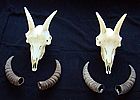 The skulls of the last two bucardo, in the Pyrenean Institute of Ecology (CSIC), Jaca. Courtesy by Bucardo.es. All rights reserved. www.bucardo.es/ |
|
|
|
Post by another specialist on May 1, 2009 7:48:29 GMT
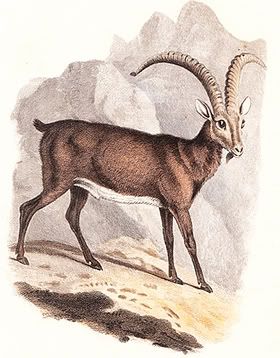 Cuvier (1817) 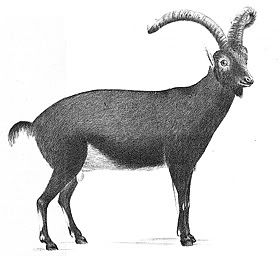 SCHINZ (1837) Courtesy by Bucardo.es. All rights reserved. www.bucardo.es/ |
|
|
|
Post by another specialist on May 1, 2009 7:50:13 GMT
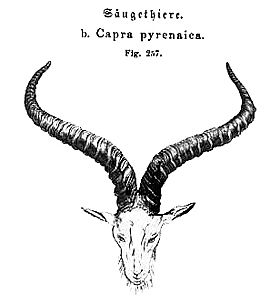 Blasius (1857 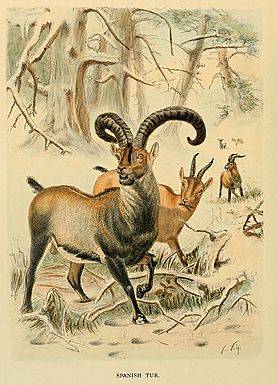 Lydekker (1898) Courtesy by Bucardo.es. All rights reserved. www.bucardo.es/ |
|
|
|
Post by another specialist on May 1, 2009 7:53:23 GMT
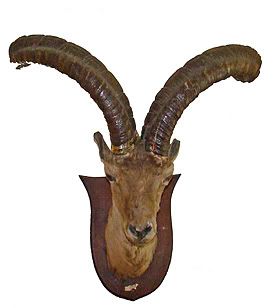 Luchon museum (photo KW, 2008).  University of Zurich (photo KW, 2008). 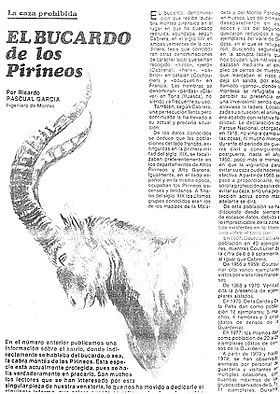 In 1981 the then director of the National Park of Ordesa, Ricardo Pascual Garcia advised to change the policy of preserving the bucardo. The captive breeding should be the most important pillar for conservation, as explained in this article in the journal Trophy No 141 of 1982. Courtesy by Bucardo.es. All rights reserved. www.bucardo.es/ |
|
|
|
Post by Bucardo on Jan 1, 2012 21:32:32 GMT
|
|
|
|
Post by nancyw on Jan 2, 2012 20:00:30 GMT
Does anyone know if they are still trying to clone this species. Is the cloning project still ongoing or has it been abandoned?
|
|
|
|
Post by Melanie on Jul 3, 2012 10:37:56 GMT
|
|
|
|
Post by surroundx on Nov 26, 2017 4:55:22 GMT
|
|
|
|
Post by surroundx on Feb 25, 2018 2:47:50 GMT
Ureña, I. et al. (2018). Unraveling the genetic history of the European wild goats. Quaternary Science Reviews 185: 189-198. [ Abstract] |
|
|
|
Post by surroundx on Jul 5, 2019 8:08:02 GMT
Kees Woutersen has informed me that his latest book on the Bucardo or Pyrenean ibex ( Capra pyrenaica pyrenaica) has been published this month in Spanish. It is titled "El camino de los bucardos" and is 128 pages. A summary of the book: "The goal of the book is to connect the history of the bucardo with the present through a guide whose content is divided into three parts. Routes are described pointing to historical places where the bucardos lived, testimonies and experiences of people who were dedicated to protecting the bucardo in the 20th centuryand translated writings of 19th century hunters that relate encounters with bucardos. The Bibliography of the experiences dates back to 1842 and includes interviews with guards the national park of ordesa and monte lost and inhabitants of torla." A pdf preview of the book: bucardo.es/documents/Vistaprevia-ElcaminodelosBucardos-julio2019.pdfThe new Facebook page for the new book. www.facebook.com/El-camino-de-los-Bucardos-574395329634171/ |
|
|
|
Post by Melanie on Sept 1, 2019 12:56:46 GMT
|
|